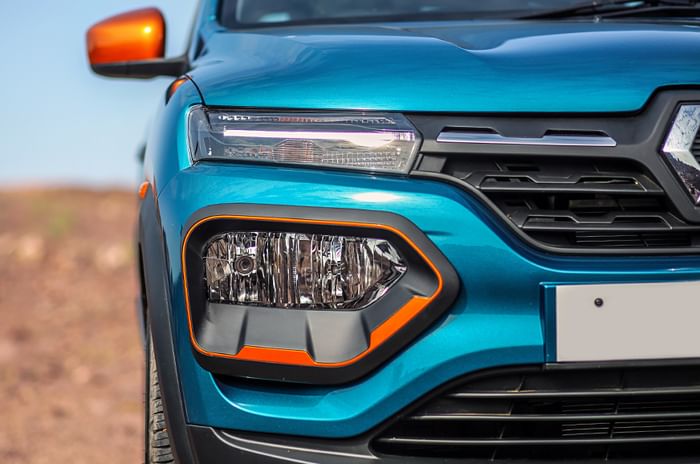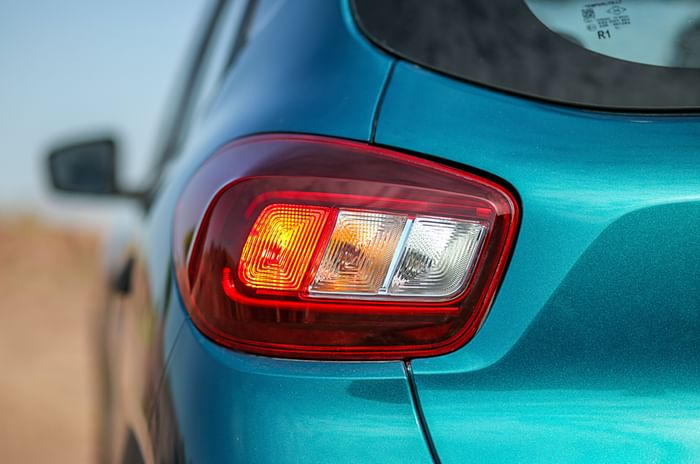What is it?
With its SUV-inspired looks, touchscreen infotainment system and digital dials, the game-changing Renault Kwid successfully established that a budget hatchback need not be a basic hatchback. Renault has also done well to update the Kwid regularly but what you see here is the most comprehensive refresh yet. The Kwid’s got a new look, a refreshed cabin and more features.
As before, the Kwid is available with a 54hp, 0.8-litre petrol engine, and a 68hp, 1.0-litre petrol engine that can also be had with an AMT automatic. Do note, the engines are still in BS4-spec. BS6-compliant versions will come closer to April 2020 when the new emission norms take effect. Our test car is a Kwid 1.0-manual in top-spec Climber form.
What’s it like on the outside?
The Kwid was a smart hatchback to start with and 2019’s changes have made it more attractive still. Styling up front is all new and the new-age split headlamp setup, with LED DRLs on top and the main headlight lower down, conforms to latest trends. The DRLs look striking and what’s particularly noteworthy, is that they are standard across all variants. The large main headlights on the bumper get chunky black bezels that are embellished with orange accents on the Climber.

With the update, Renault has upsized the Kwid’s wheels from 13-inchers to 14-inchers across the line-up. The larger rims and chunkier 165/70 R14 tyres give the little Renault a more confident stance. As an added plus, ground clearance is also up 4mm to 184mm. Attractive smoked grey plastic wheel covers are part of the package on the Kwid Climber, while regular versions make use of simpler covers. LED guide lights in the tail-lamps and the inclusion of reflectors, meanwhile, have helped spruce up the Kwid’s rear.

A brochure-to-brochure comparison of the old and new Kwid will also tell you that the 2019 model is 52mm longer and 35-40kg heavier than the original. The increase in length is courtesy the new bumpers while the weight increment is down to the additional structural reinforcements at the front and sides required to comply with the latest crash and pedestrian safety norms.
What’s it like on the inside?
Those familiar with the Kwid will be quick to notice the changes inside the cabin. Things like the new steering wheel that’s wrapped in perforated leather, the new instrument cluster and larger touchscreen sure help make the right first impression. The digital instrument cluster that also includes a tachometer is a huge step up from the previous one. The display is crisp and clear and the absence of a glass before the instrument cluster means there are no reflections at all. What’s also impressive is the new 8.0-inch touchscreen infotainment system. It is slick to use and it features Android Auto and Apple CarPlay.
The dashboard gets some design changes as well and a few controls have been shuffled and rearranged to make it more ergonomic. The storage recess atop the glovebox has been done away with while the glovebox itself has been made a size or two larger. New to the Kwid is the option of a passenger side airbag (it's only available with the 1.0-litre engine). The airbag housing takes the place of the secondary glovebox that was notorious for its flimsy lid. Also, in the AMT variant, the gear selector knob is no more on the dashboard, but has been moved to the console between the seats. All said, while the new design and layout looks a lot more upmarket than before, the quality of materials hasn’t improved. There are still plenty of places where cheap plastics have been used and an improvement here would have helped uplift the ambience to another plane.
The front seats have been carried forward unchanged so you are seated at a good height that provides a good view of the road. Although the cushioning is slightly on the firmer side, there’s good side and under-thigh support. Get in the back seat, and you are sat low, which results in a knees-up seating position. The seat base isn’t very long and you don’t have a lot of under-thigh support here either. There is reasonable headroom and legroom for average-sized adults but space is significantly down on the taller Maruti S-Presso. The Kwid Climber does remain the only car in its class to offer the comfort of a rear centre armrest.
Interestingly, boot space has gone down from 300 litres to 279 litres. The switch to larger 14-inch wheels and the requirement for bigger wheel wells has resulted in slightly less room for luggage. The rear seat backrest can be folded to make more room though.
What features does it get?
All versions of the Kwid get ABS, a driver airbag, reverse parking sensors, speed warning system and seatbelt reminders, as mandated by latest requirements. As mentioned, a passenger side airbag is a paid option.
You’ll be quite surprised by how many comfort and convenience features top-spec Kwids pack in. The Kwid Climber gets modern day essentials like front power windows (rear power windows are an option), remote central locking and power steering. Over and above this LED DRLs, an 8.0-inch touchscreen and digital dials are also part of the package.
What’s it like to drive?
If you are buying a Kwid, it’s worth your money to spend extra for the larger-hearted Kwid 1.0. The 68hp, 1.0-litre, three-cylinder petrol engine is leagues better than the humdrum 54hp, 0.8-litre unit. That said, the Kwid’s 1.0 engine isn’t perfect. The engine is always audible inside the cabin at idle and gets quite loud at high revs too. Get a move on, and you will notice that the power delivery isn’t very instantaneous. At low speeds, the buildup of speed is quite slow and it lacks the strong bottom-end of the Alto K10. So, while getting around in the city, you will have to downshift to make those quick overtakes or to close in on a gap. Things are slightly better in the mid-range: this is where you can feel the progress in speed. The power dies down after 4,000rpm and it is better if you upshift at this point as the engine gets quite loud after this point. The 5-speed manual gearbox has medium length throws and, coupled with a light clutch, moving through gears isn’t very cumbersome.
Has the 4mm increase in ride height and the shift to wider 165/70 R14 tyres made a difference to the driving experience? Not a major difference, but yes, it has. The Kwid has lost some of its pliancy at low speeds, and there is a bit more movement over bad roads. The suspension handles potholes well, but isn’t very silent and you can hear it working over a bad patch of road. As before, though, the Kwid feels quite planted and surefooted at high speeds for what is a bantam-weight car. Stability is decent and the wider tyres also give more confidence in the corners. A sore point is the steering – while light and easy to use at low city speeds, it lacks self-centering and does not weigh-up sufficiently at high speeds either.
A point worth noting is that as a result of bigger and wider tyres, and added weight, the claimed fuel efficiency figures have dropped significantly across all the engine and gearbox options. The 0.8L has a claimed fuel efficiency of 22.30kpl (2.87kpl less) while the 1.0-litre engine has a claimed fuel efficiency of 21.70kpl (MT) and 22.50kpl (AMT), which is a drop of 1.34kpl and 1.54kpl, respectively.
Should you buy one?
The Renault Kwid facelift has been launched at a price of Rs 2.83 lakh to Rs 4.92 lakh (ex-showroom, Delhi) which makes it a great value buy. Do note, prices will increase once the BS6 versions come in the near future.
In all, the enhanced look and equipment have made the Renault Kwid more appealing than ever before. Question is, is it still the best budget hatchback to buy? To know the answer, read how the updated Kwid fares against the new Maruti Suzuki S-Presso.
Photography: Gaurav Thombre
Click here for Renault India models, prices, reviews, videos, images and more




